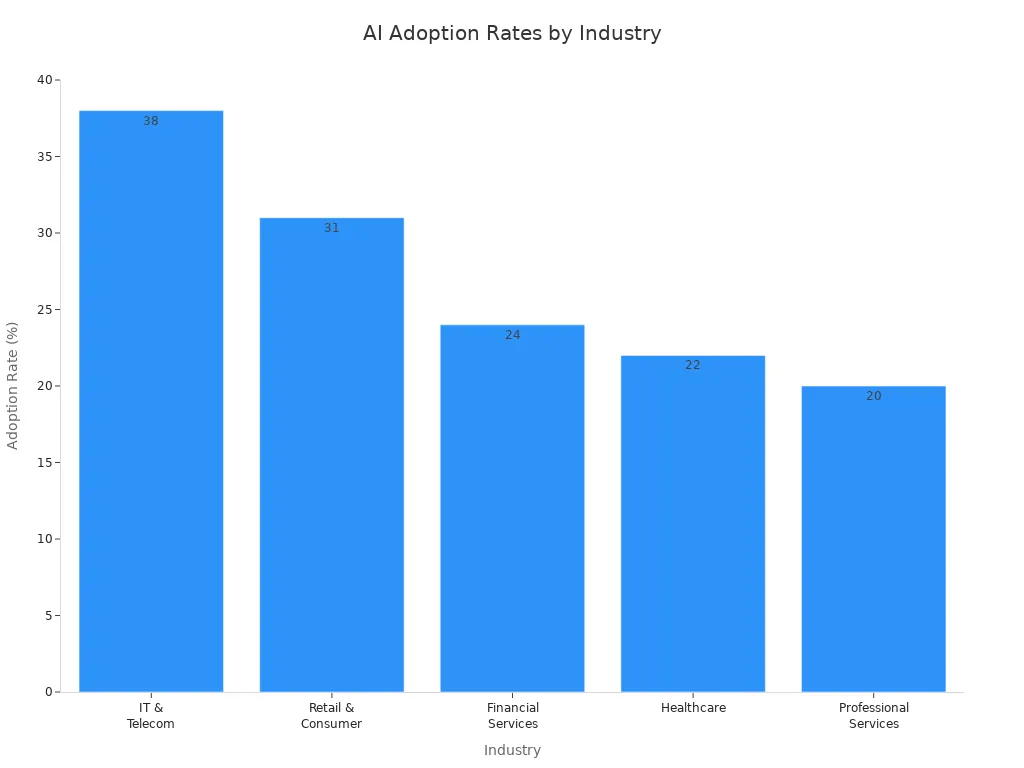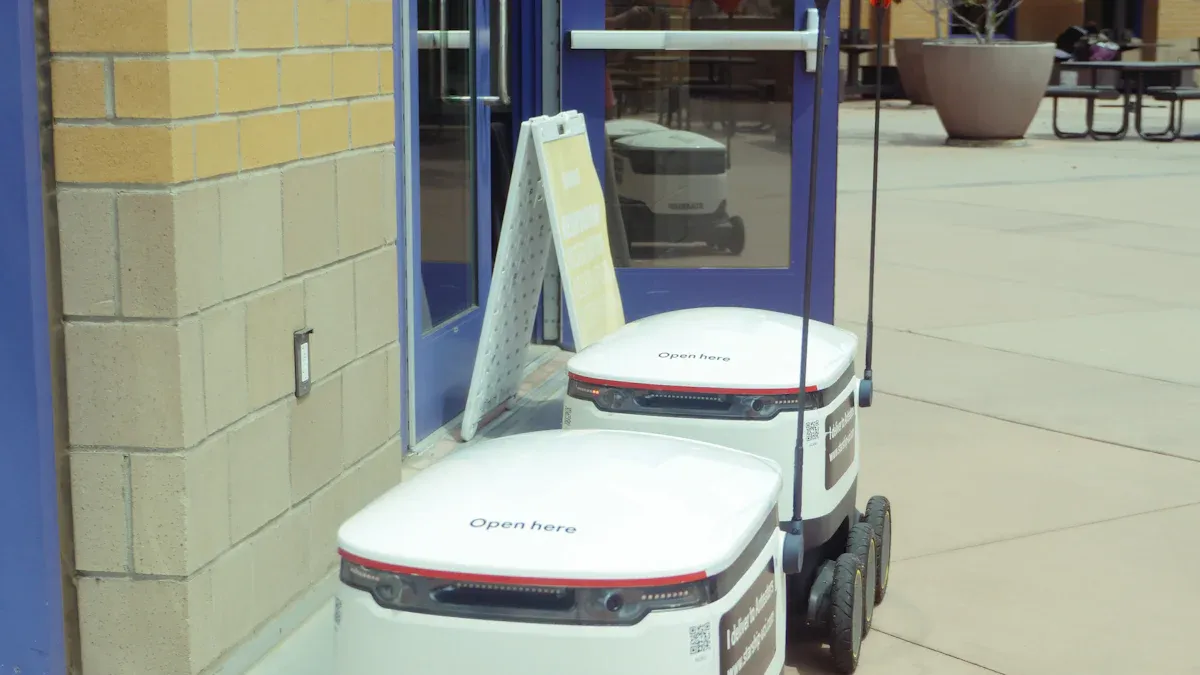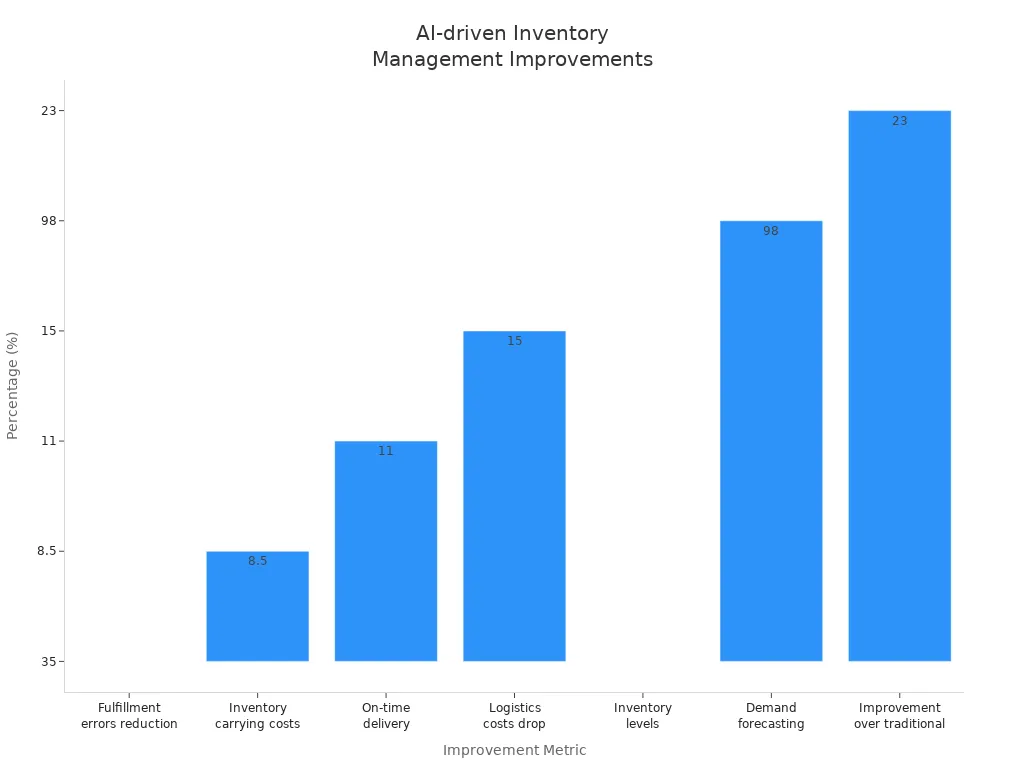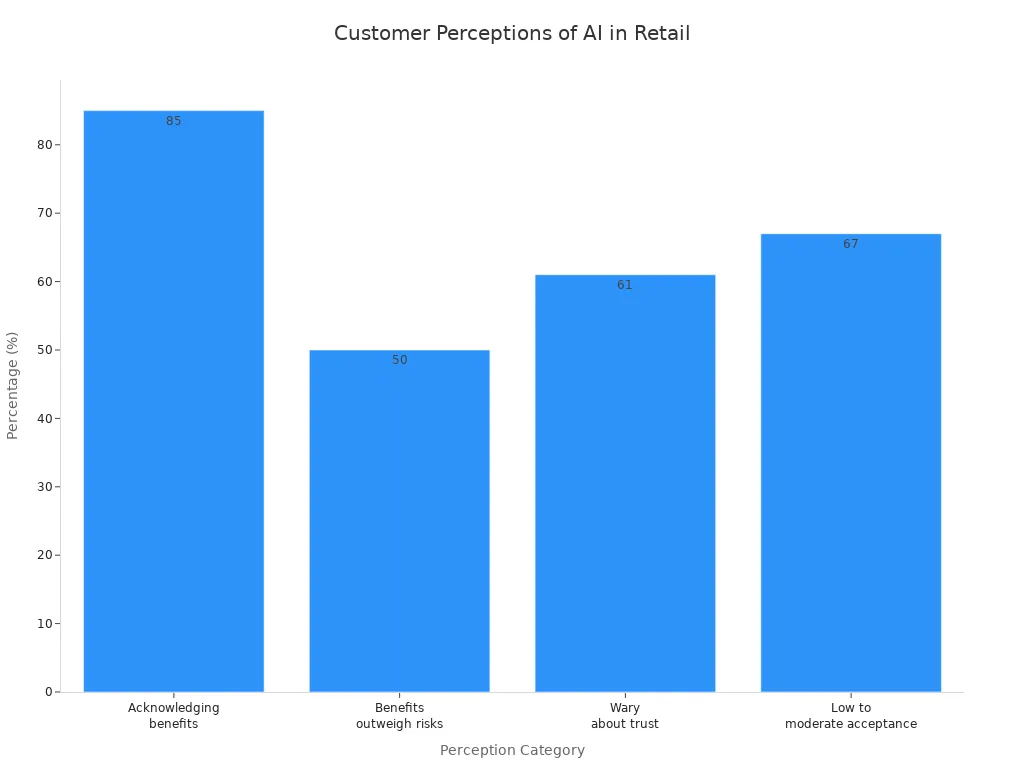How Their AI Works and its Impact on Retail

AI is changing the way you manage retail operations and improve the shopping experience. You see this in how stores use autonomous agents to handle 80% of customer interactions by 2025. The global AI market in retail is growing fast, reaching USD 11.61 billion in 2024 and set to hit USD 14.49 billion in 2025.

You notice that 31% of companies in retail and consumer sectors have adopted AI. The table below shows how retail compares to other industries:
Industry | AI Adoption Rate |
|---|---|
IT & Telecom | 38% |
Retail & Consumer | 31% |
Financial Services | 24% |
Healthcare | 22% |
Professional Services | 20% |
You can learn How Their AI Works to boost your own experience and create better results for your retail business.
Key Takeaways
AI is transforming retail by automating tasks and improving customer interactions, leading to better efficiency and satisfaction.
Using AI technologies like chatbots and personalized recommendations can enhance customer engagement and loyalty.
High-quality data is essential for effective AI applications; ensure your data is accurate and secure to maximize benefits.
AI helps retailers optimize inventory management, reducing costs and improving fulfillment accuracy.
Embrace AI trends like hyper-personalization and sustainability to stay competitive and meet customer expectations.
How Their AI Works

AI Technologies
You see how their ai works by combining several advanced technologies that drive retail transformation. These ai applications help you create smarter searches, improve customer service, and optimize store operations. When you use artificial intelligence in your retail business, you unlock new ways to understand your customers and manage your inventory.
Here is a table showing the main ai technologies and their applications in retail:
AI Technology | Application Description |
|---|---|
Custom Recommendations | AI algorithms provide targeted product recommendations based on customer data. |
Dynamic Pricing | Adjusts prices based on demand, competitor activity, and customer profiles. |
Demand Forecasting | Machine learning models predict demand using sales history and market trends. |
Inventory Optimization | Helps retailers manage stock levels to reduce waste and prevent stockouts. |
Visual Search | Allows customers to upload images to find products, enhancing discovery. |
Chatbots | NLP-powered chatbots assist customers with real-time support and personalized suggestions. |
Fraud Detection | Identifies patterns indicative of fraud to enhance transactional security. |
Supply Chain Optimization | Automates logistics operations for better demand-supply alignment and route planning. |
Marketing Insights | AI-driven segmentation models create relevant marketing campaigns based on customer data. |
In-Store Analytics | Monitors foot traffic and product availability to inform merchandising decisions. |
Smart Shelf Technology | Uses sensors to maintain inventory accuracy and improve in-store responsiveness. |
You can use these ai applications to make your retail business more efficient. For example, smarter searches let your customers find products faster. Visual search helps shoppers discover items by uploading photos, making the shopping experience more interactive. Chatbots answer questions and guide customers, saving you time and improving satisfaction.
Machine learning algorithms play a big role in how their ai works. You benefit from personalized recommendations, fraud detection, and dynamic pricing. These algorithms analyze customer data and transaction patterns to create tailored offers and flag unusual activities. You can also use sentiment analysis to track feedback and adjust your strategies. Smarter searches and frictionless shopping experiences make your store more appealing.
Tip: You can boost sales and customer loyalty by using ai applications like demand forecasting and automated inventory management. These tools help you predict trends and keep your shelves stocked with the right products.
Data and Integration
You need high-quality data to make ai work in retail. How their ai works depends on integrating different types of information from your business. You collect sales data, customer data, inventory data, and supply chain data to power ai applications. Smarter searches rely on accurate product information and customer preferences.
Here is a table showing the most common data types used in retail ai systems:
Data Type | Description |
|---|---|
Sales Data | Transaction details, revenue figures, and sales channel performance for financial insights. |
Customer Data | Information on shopping behaviors, preferences, and demographics for personalized marketing. |
Inventory Data | Real-time stock visibility to manage inventory efficiently and minimize stock issues. |
Supply Chain Data | Information about suppliers and logistics to optimize goods flow from manufacturers to retailers. |
Marketing and Promotions Data | Data from various channels to measure promotional impacts and optimize strategies. |
Employee and HR Data | Staffing and performance data to enhance workforce management and satisfaction. |
E-commerce Data | Website analytics and online sales data for a unified retail strategy in online presence. |
You must ensure your data is accurate and secure. You can use processes to detect and correct errors, measure accuracy, and maintain consistency. You protect customer information by using encryption and access controls. You follow privacy laws like GDPR and CCPA to keep data safe. You also set clear policies for data retention and disposal.
When you integrate data from different sources, you create a unified view of your retail operations. This helps ai applications deliver smarter searches, better recommendations, and more efficient inventory management. You can track sales trends, monitor customer behavior, and optimize your supply chain.
Note: You improve your ai results by keeping your data clean and secure. Regular audits and privacy impact assessments help you find and fix risks before they affect your business.
You see how their ai works by connecting technologies and data. This combination lets you offer smarter searches, personalized experiences, and efficient operations in your retail store.
AI in Retail Applications

Inventory Management
You can use ai in retail to manage inventory more efficiently. Many retailers rely on systems like Oracle Inventory Management and SAP Inventory Manager. These tools help you track products in real time and reduce errors. You see improvements in fulfillment, lower costs, and better delivery times. The table below shows how ai in retail improves inventory management:
Improvement Metric | Result |
|---|---|
Fulfillment errors reduction | 35% reduction |
Inventory carrying costs reduction | 8.5% reduction |
On-time delivery improvement | 11% improvement |
Logistics costs drop | 15% drop |
Inventory levels improvement | Up to 35% improvement |
Demand forecasting accuracy | 98% accuracy |
Improvement over traditional methods | 23% improvement |

You can use ai to manage perishable goods in grocery stores. Computer vision systems check freshness and set prices to reduce waste. Real-time tracking helps you keep shelves stocked and avoid shortages.
Personalization
You can create a personalized shopping experience for every customer using ai in retail. Ai analyzes data from ecommerce platforms, including purchase history and browsing behavior. You can offer personalized product recommendations and targeted marketing. For example:
A customer visits your online store.
Ai tracks their actions and interests.
You show personalized product recommendations based on their behavior.
Retailers like Sephora use personalized loyalty programs to increase customer retention by up to 30%. Ai in retail helps you build personalized experiences that make customers feel valued and encourage repeat shopping.
Customer Engagement
Ai in retail boosts customer engagement with tools like ai-powered chatbots, virtual assistants, and augmented reality. You can provide 24/7 support and answer questions instantly. Ai-powered chatbots handle many queries at once and give personalized product recommendations. You can use sentiment analysis to understand feedback and improve your service. Optimized loyalty programs reward customers based on their shopping habits.
Chatbots and virtual assistants offer instant help.
Augmented reality lets customers try products virtually.
Voice assistants make shopping easier and faster.
Operations
You can improve retail operations by using ai for inventory management, order tracking, and customer relationship management. Ai in retail helps you make faster decisions and adapt to changes in demand. You can automate reordering, track shipments, and personalize communications. Ai reduces costs and increases productivity. You also get better visibility across your retail chain and ecommerce sites.
Ai in retail helps you prevent loss and detect fraud. Ai systems analyze video feeds and transaction data to spot suspicious behavior. You can protect your business and keep your customers safe.
Tip: You can use ai in retail to combine customer data, inventory levels, and pricing information. This helps you offer personalized product recommendations and improve the shopping experience for everyone.
Impact of AI
For Retailers
You see ai changing retail in many ways. When you use ai, you automate tasks and reduce errors. This helps you make better data-driven business decisions. You empower your employees by giving them quick access to information. This support is important in stores with high turnover.
Here is a table showing the main benefits for retailers who use ai:
Benefit | Description |
|---|---|
Task automation | Automates repetitive tasks and reduces errors in data collection and analysis for demand forecasting and pricing. |
Employee empowerment | Gives store associates fast access to information, improving efficiency and support. |
Loss prevention | Matches orders with invoices and detects fraud, reducing shrinkage and supplier overcharges. |
Waste minimization | Identifies perishable items for discounting or donation, helping you reduce waste and improve sustainability. |
Supply chain optimization | Optimizes delivery routes and loading processes using real-time data, making logistics more efficient. |
Customer satisfaction | Creates personalized offers and improves service through ai-driven insights, leading to higher satisfaction. |
Error reduction | Automates data collection to minimize manual errors, improving accuracy in sales and demand forecasts. |
Cost reduction | Improves forecasting accuracy, lowering inventory costs and reducing labor expenses. |
You use predictive analytics to forecast demand and set prices. Ai-driven analytics help you place products in the best spots and test new layouts. You learn from customer interactions and adjust your marketing strategies. During busy times, ai tools help you manage resources and prevent stock shortages.
Ai uses historical data to predict future scenarios and recommend product placement strategies.
Real-time testing with ai lets you refine your store layout based on customer journeys.
Ai analyzes demand, competition, and costs to suggest the best pricing strategies.
Ai improves visibility into your supply chain, helping you manage inventory and forecast demand.
You make smarter data-driven business decisions when you use ai. You see improvements in marketing, inventory management, and customer intelligence. Ai helps you reduce costs and increase profits.
For Customers
You notice ai making shopping easier and more personal. Ai personalizes customer journeys by offering product suggestions and targeted marketing. You get 24/7 support from chatbots and virtual assistants. Ai streamlines workflows, so you spend less time waiting and more time shopping.
Lush, a cosmetics brand, used ai agents to handle common requests. Human agents focused on building deeper relationships. This led to an 82 percent one-touch resolution rate and a 369 percent return on investment in one year. The company saved $434,000 in costs.
According to Zendesk Benchmark data, 77 percent of business leaders say that more personalization leads to higher customer retention rates. Ai improves customer experience by making interactions smoother and more relevant.
Here is a chart showing how customers feel about ai-powered retail services:

You see many customers want ai assistance during product experiences. The table below shows what customers prefer:
Statistic | Percentage |
|---|---|
Consumers wanting AI assistance during product experiences | 52% |
Consumers favoring personalized offers | 47% |
Consumers looking for AI-driven product suggestions | 42% |
You also notice that some customers still want human support. The next table shows these preferences:
Statistic | Percentage |
|---|---|
Consumers who feel their issues require human support | 85% |
Consumers who believe chatbots can solve problems efficiently | 35% |
Most people see the benefits of ai, but some are cautious. The table below shows how customers view ai in retail:
Statistic | Percentage |
|---|---|
People acknowledging benefits of AI | 85% |
People believing benefits outweigh risks | 50% |
Customers wary about trusting AI systems | 61% |
Customers reporting low to moderate acceptance of AI | 67% |
Ai helps you get personalized offers and product suggestions. You enjoy faster service and better customer satisfaction. Ai improves customer experience by making every interaction count.
Challenges
You face several challenges when you use ai in retail. Many retailers start without a clear ai strategy. Poor data quality can cause problems for predictive analytics and customer intelligence. Integrating ai with old systems is often hard and expensive.
Here are some common challenges:
Lack of a clear ai strategy can slow down progress.
Poor data quality affects the accuracy of ai and predictive analytics.
Integrating ai with legacy systems creates bottlenecks.
High costs for hardware, software, and skilled workers can limit adoption.
Talent shortages make it hard to find experts in ai and marketing.
Ethical concerns include privacy, bias, and explainability.
Over-reliance on ai may lead to wasted resources if you expect it to solve every problem.
Scalability can be difficult as your business grows.
Change management is important to help employees adapt to new processes.
Regulatory and ethical issues also impact ai in retail. You must check your data for bias and protect customer privacy. You need to make ai systems transparent and easy to understand. Most shoppers want retailers to disclose how they use customer data in ai applications. Many want the right to access and review their data, and most want to give explicit consent for data usage.
Note: You improve trust in ai by being transparent about how you use customer data and by following privacy laws.
You must balance the benefits of ai with the need for ethical practices. You make better data-driven business decisions when you address these challenges and build trust with your customers.
Future of AI in Retail
Trends
You will see ai changing retail in new ways over the next five years. Many stores now use ai shopping assistants that guide you, answer questions, and give personalized recommendations. These assistants go beyond simple chatbots and make your shopping journey smoother.
Retailers use hyper-personalization to deliver offers and content that match your interests in real time. Ai looks at your behavior and context to create unique experiences across every channel. Conversational commerce is growing fast. You can shop using voice or text with smart assistants, making the process faster and more accessible.
Sustainability is another big trend. Ai helps retailers optimize logistics and packaging. You see stores using ai to reduce waste and lower emissions, meeting customer expectations for greener practices.
Here is a table showing the most important trends in ai for retail:
Trend | Description |
|---|---|
AI Shopping Assistants | Guide users, answer questions, and provide personalized recommendations autonomously. |
Hyper-Personalization | Real-time tailored content and offers across all channels. |
Conversational Commerce | Voice and text shopping with smart assistants for speed and accessibility. |
Sustainability | Optimizes logistics and packaging to reduce waste and emissions. |
Opportunities
You can use ai to create new opportunities in retail. Generative ai helps you offer personalized product recommendations and interactive shopping experiences. Companies like Sephora use ai for skin analysis tools, while Estée Lauder speeds up campaign development and product design. Home Depot uses ai to support employees with expert-level product knowledge.
Ai-driven automation lets you move from reactive to proactive operations. You can automate inventory reordering and adjust pricing based on real-time data. This gives you more time to focus on innovation. Ai also improves warehousing, checkout systems, and workforce management. You see faster supply chains, fewer errors, and better customer service.
To prepare your workforce for ai, you should map ai solutions to your business goals. Create learning plans for different teams and use hands-on training. Ai can automate scheduling, forecast staffing needs, and match employee skills to tasks. This helps you make better decisions and stay compliant with labor laws.
Tip: You can stay ahead in retail by adopting ai tools, training your team, and focusing on customer experience.
You see ai driving a major shift in retail, from inventory management to customer engagement.
"AI isn’t just an incremental improvement; it represents a paradigm shift in AI inventory management."
Retailer | AI Implementation | Key Outcomes |
|---|---|---|
Walmart | Autonomous Inventory Management | 30% fewer out-of-stock events |
H&M | AI-Driven Visual Merchandising | 17% bigger basket size |
Amazon/Shopify | Personalized Shopping Assistants | 25% higher order values |
To stay competitive, you should:
Invest in predictive analytics and ai talent.
Modernize IT and measure ai impact.
Focus on personalization and customer experience.
Industry experts predict ai will unlock new insights and create hyper-personalized shopping. You can prepare by learning about new ai trends and updating your strategy.
FAQ
What is the main benefit of using artificial intelligence in stores?
You can use artificial intelligence to automate tasks and improve accuracy. This helps you save time and reduce mistakes. Your team can focus on helping customers and growing your business.
How does artificial intelligence help with customer service?
You can use chatbots and virtual assistants to answer questions quickly. These tools give customers support at any time. You can also use them to offer product suggestions and solve problems faster.
Is it hard to add artificial intelligence to my current systems?
You may face some challenges when you add artificial intelligence to your systems. You need good data and the right tools. Many companies offer support and training to help you get started.
Will artificial intelligence replace store employees?
You will still need employees in your store. Artificial intelligence helps with simple tasks and gives your team more time to help customers. Your staff can focus on building relationships and solving complex problems.
How can I keep customer data safe when using artificial intelligence?
You should use strong security tools and follow privacy laws. You must protect customer information with passwords and encryption. Regular checks help you find and fix risks before they cause problems.
See Also
The Future of Retail Lies in AI-Driven Stores
Understanding the Growth of AI-Enhanced Corner Shops
Transforming Online Retail Management with AI Tools
